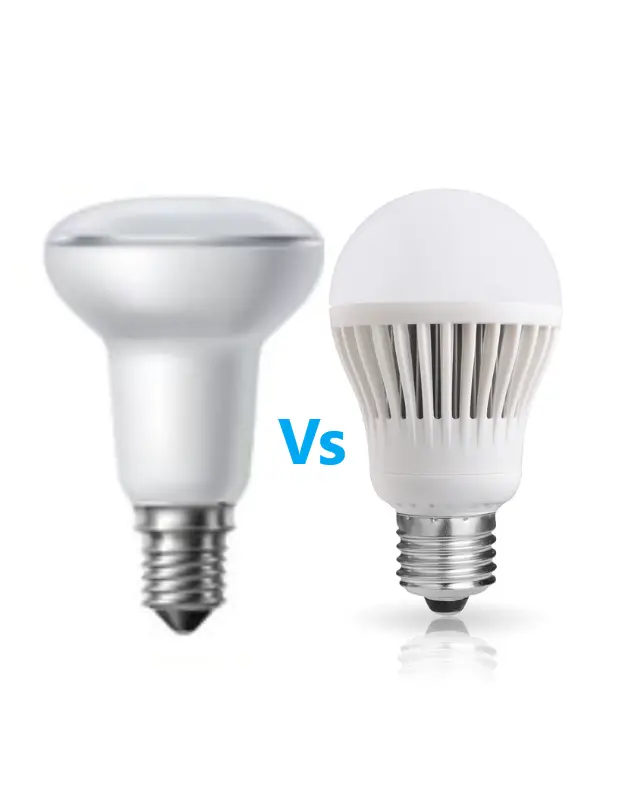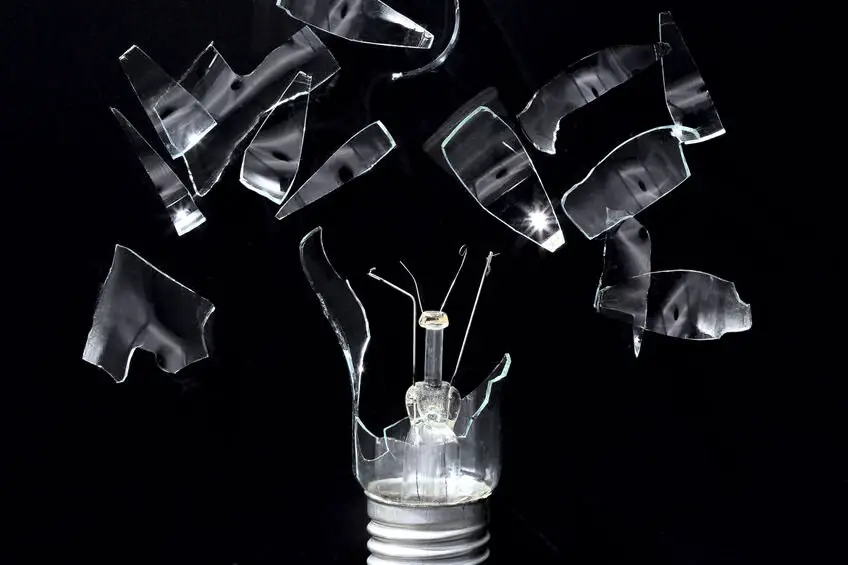The Different Types Of Light Bulbs
With the evolution of technology, there have been a lot of advances in lighting and different types of bulbs. Here we will learn about the most common light bulbs, how they work and what they are best used for.
Contents
Incandescent Bulb

The incandescent bulb is the first of all light bulbs, it is the same bulb that was invented by Thomas Edison in 1876. It is what most people think of when they think of a “light bulb“, as it is the first of its kind and therefore also very iconic.
Specifications:
-Lifespan: ~1000 hours
-Efficiency: 10-12 lm/W
-Colour Temperature: 2700K
-CRI: 100
How It Works
The incandescent light bulb works by sending an electrical current through a tungsten/wolfram filament that heats up and produces light once reaching sufficient temperature.
These temperatures can be as high as 2500 °C (4600 °F) in the actual filament. This means that we need a material durable enough for this, which is why tungsten was chosen. If you are interested further in why tungsten specifically was chosen for this, you can find out more about that here.
This factor however is also what causes the lifespan and efficiency to be rather low in comparison to some of the other bulbs on this list.
Lifespan
The high temperature of the filament is what creates the glow to begin with, but it also is the same thing that keeps the lifespan low.
It is very difficult for any material to survive such high temperatures without suffering severe damage, let alone for a longer period of time.
This is the main reason the lifespan of this bulb type is only ~1000 hours, because after the bulb has been lit for this many hours the filament will break and therefore stop producing light.
In order to increase the lifespan of a bulb like this it is possible to decrease the voltage its connected to as that will decrease the electrical current going through the filament.
However, you lose a lot of light doing this, which causes the light bulb to become more of a heater than it does a light source.
Efficiency
The efficiency of an incandescent bulb is around 10-12 lumen/Watt.
Lumen/Watt is a way to measure the efficiency of a bulb by taking the quantified light output (lumen) and dividing it by the amount of inputted energy (Watt). That way you can determine and compare the energy efficiency between different light sources.
In comparison to other bulbs, a lumen/watt of 10-12 is rather low. The reason for this also has to do with the heat it produces.
The reason for this is that most of the energy input into the bulb goes towards heat generation instead of light generation. In fact, only about 5% of the inputted energy goes toward creating light whereas the other 95% goes towards creating heat.
Usage
While these light bulbs were an incredibly important invention for its time, they don’t have much of a use in today’s society.
This type of bulb has been outclassed in just about every way by other more modern bulbs, deeming this one redundant.
In addition to being outclassed by other bulbs, they were also deemed as very inefficient in comparison to most other bulbs. For this very reason, it has been decided by most of the world that it is about time to start phasing these bulbs out for newer and better ones.

It still sees a bit of usage however in a few different areas. The most prominent area they are still used in is within industries because they are rather reliable in those kinds of environments. As time goes on these bulbs also get replaced with more modern bulbs.
They also work very well in a home setting. This is mainly because the light it gives off is 2700K, which is a very warm colour of light. This gives off a feeling of warmth and coziness, which is usually the desired feeling for home environments.
Halogen Bulb
The halogen bulb is an evolved and improved form of incandescent bulb technology. The main difference between the two is the addition of halogen gas inside of the bulb.

Specifications:
-Lifespan: 2000-5000 hours
-Efficiency: 20-36 lm/W
-Colour Temperature: 3000-3400K
-CRI: 100
How It Works
The halogen bulb works much the same way as a regular incandescent bulb. It is constructed using the same principle, it has a tungsten filament that heats up and emits a glowing white light.
The actual difference between the two lies within how the halogen interacts with the filament and subsequently increases the bulbs lifespan.
Lifespan
Contrary to the incandescent bulb which is very similar to the halogen one, the halogen bulb lasts up to 5000 hours while the incandescent bulb only lasts about 1000 hours.
This is because the halogen serves a very special function inside of this bulb. This special function is to “catch” the particles of evaporating tungsten that occurs in regular incandescent bulbs.
With the original bulb design the tungsten filament will steadily evaporate through its lifespan due to its high temperature. When this happens the evaporated tungsten particles will simply shoot outwards and hit the glass of the bulb, which will cause it to blacken.
This effect gets minimized a lot by adding halogen to the bulb. The halogen will chemically bind with the tungsten particles and eventually find its way back to the original filament where it will keep on producing light until the filament breaks.
This acts as a regenerating function where the glowing filament is able to “heal“ from the damages it suffers from operating at high temperatures.
The system isn’t perfect however, because the filament still gets slightly damaged every time this happens, but it definitely has a significant positive impact if you compare it to the original design.
Efficiency
The luminous efficiency of a halogen bulb is around 20-36 lm/W. This makes it about twice as energy efficient as its incandescent counterpart.
They manage this because of their ability to operate at a higher temperature than the incandescent bulb, which also causes it to produce more light.
This however also means that they take more energy to run than other bulbs, making it a bit misleading to say that it is more efficient.
It is more efficient if your goal is to produce a lot of light at a higher efficiency, but if you are not looking to produce an overwhelming amount of light it is most likely not the option you want to go for. This comes down to what the preferred function is and what the bulb is used for.
Usage
The main usage for the halogen bulb are as car headlights and theatre spotlights. This is because for these applications the high operating temperature isn’t a problem and having a high light output is desirable.

They are especially good at being theatre spotlights because of its great light quality. The best light quality comes from light sources which in one way or another burn, such as the sun or a fire, or in this case a filament inside of the bulb.
This makes the halogen bulb desirable for environments such as the theatre, because delivering visual effects is a big part of it.
As mentioned they have also been used quite a bit as car headlights. Nowadays they are mostly getting replaced with more modern LED ones, but they definitely still exist and serve this purpose to this very day.
One thing to note about halogen bulbs though is that they are generally not used for homes. They have seen a decent amount of usage in homes as they have a good quality of light, but much like the incandescent bulb they are simply too inefficient for today’s standards.
This is why they are also going to be phased out for home usage. The details of when they are expected to be completely banned is not certain yet since the phasing out of halogen bulbs is a rather recent development.
Compact Fluorescent Bulb (CFL)
The Compact Fluorescent bulb (or CFL) is a compacted bulb version of the fluorescent tubular lamp. This gives them very similar properties to the tubes they were originally based on.
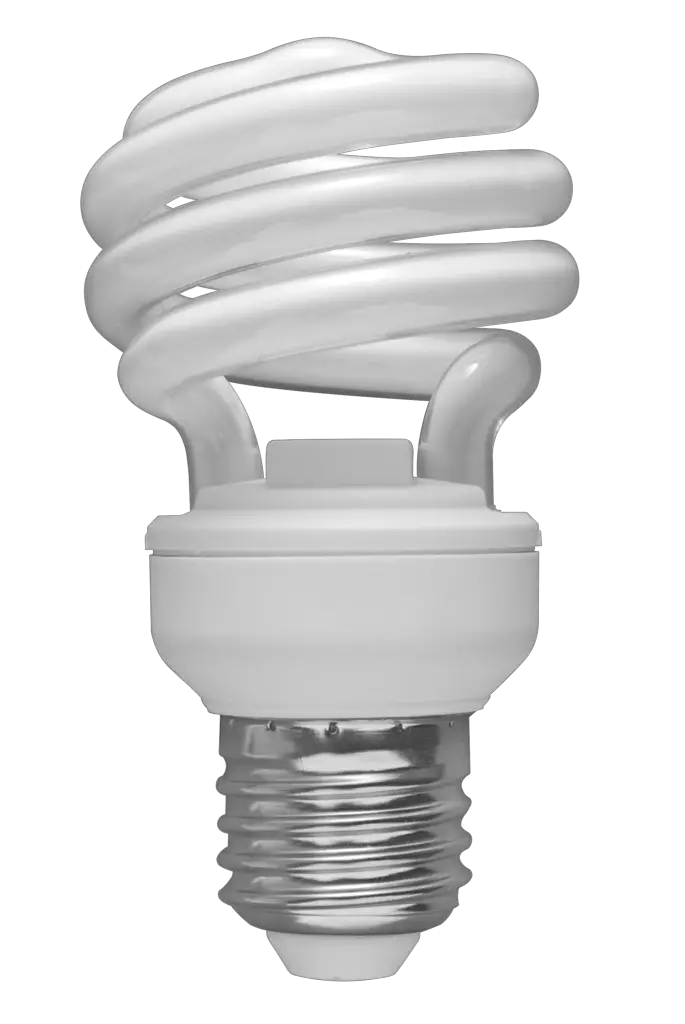
Specifications:
-Lifespan: 10 000-15 000 hours
-Efficiency: 50-70 lm/W
-Colour Temperature: 2700-4000K
-CRI: 85+
How It Works
The way these bulbs are constructed is a little bit more complex than some other bulbs, because its functionality involves a slightly complicated reaction between the different components.
In order to start this bulb there are two electrodes present, one at each end of the tube. These electrodes will ignite a gas inside of the bulb (which is typically argon) and will cause the bulb to start glowing.
This gas is required for the bulb to start, but it is also required to keep the air pressure inside of the bulb. Keeping the correct air pressure in the bulb is rather important in order to minimize energy losses inside of the bulb.
The light from a fluorescent bulb gets produced by an electrical discharge that occurs between incoming electrons and the mercury atoms that are present within the bulb.
The discharge occurs when the incoming electrons hit the mercury atoms, which causes energy to release and get sent out from the bulb.
There is a problem with this however, which is that the energy that gets released is not visible light. Visible light is in a spectrum between wavelengths 350-780 nm and the wavelengths that this principle releases is between 185-250 nm, which is considered as ultraviolet light.
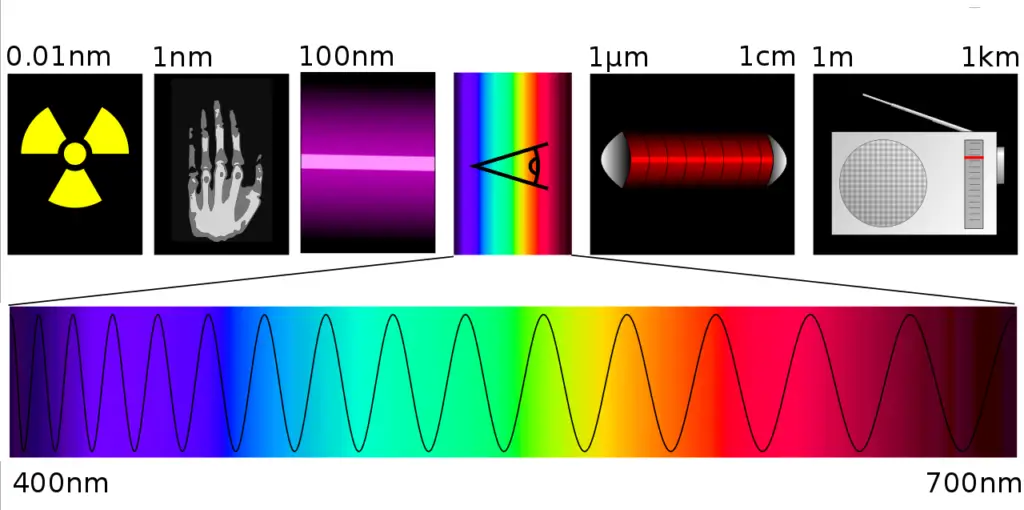
Ultraviolet light is not visible to the naked eye and can quite frankly be dangerous. Too much exposure to UV light can lead to several health-related issues such as premature ageing of the skin eye problems.
In order to turn this into a viable light source that won’t hurt us it is required to increase the wavelengths slightly so that the outputted light becomes visible. This is done by a specific “light powder“.
This “light powder“ is a fluorescent powder, which by the definition of the word “fluorescent“ emits light after absorbing light.
This is what causes the ultraviolet rays to become visible light rays because the powder absorbs the harmful UV rays and outputs a light which is visible to us.
Lifespan
The lifespan of a CFL is around 10 000 to 15 000 hours. This is quite a bit longer than the previous bulbs, which is mainly due to the way it “burns out“ is a lot different than the others.
The most common factor that causes the bulb to stop producing light is if an electrical component were to fail, for example, one of the electrodes.
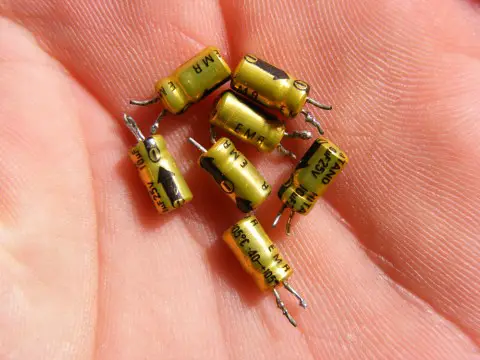
There is however one component that can be regarded as the CFL’s bottleneck in terms of its lifespan. This component is known as the electrolytic capacitor.
The reason why this component can become a bottleneck is simply due to the fact that it doesn’t run at its best when subject to a lot of heat.
A CFL bulb will reach temperatures of around 80°C (~180°F). This ties into the lifetime of the electrolytic capacitor, which has a baseline lifetime of 2000h at 105°C (220°F). Using this baseline we are able to calculate how long it should hypothetically last.
The rule for the electrolytic capacitor’s lifetime is that its lifetime will be halved for every 10°C added on and doubled for every 10°C you remove. This means that at 95°C it should last for 4000h and at 115°C it should last for 1000h.
Using this logic, the calculated lifespan of the capacitor comes out at 12 000h when you run it at the temperatures that the CFL reaches.
This makes sense as the general lifespan of the bulb is between 10 000-15 000h, meaning that there are other factors that can also cause fluctuation in its lifetime.
Efficiency
The luminous efficiency of one of these bulbs is around 50-70 lm/W. One reason why this bulb’s efficiency is much greater than that of the bulbs previously described is that it runs at a much lower temperature than the others.
The CFL runs at 80°C (~180°F), which is a lot less than the incandescent filament temperature of 2500 °C (4600 °F). This essentially means that the CFL simply wastes a lot less energy creating excess heat and instead uses that to create visible light instead.
Usage
The usage of this bulb has been quite broad for a long time. They have been pretty commonly used within home environments and other areas where a regular incandescent bulb would have otherwise been used.
This is mainly because it is overall rather energy efficient and gives off a good light quality, which made it gain a decent amount of popularity for some time.
For those reasons it is also rather versatile, which gets emphasized even more when considering that these bulbs can come in a lot of different sizes.
Since they use the same principle of a bigger tube light it is very possible to scale the principle up and down while still being able to fit into the same socket sizes as any other bulb.
However these bulbs are also on their way to being phased out. This is mainly due to the fact that they contain mercury, which is dangerous to humans and is more complicated than necessary to recycle.
Sodium Lamps
The sodium lamp is a light source that makes use of sodium which produces light when being in a chemically excited state. These bulbs come in 2 different forms: low-pressure and high-pressure sodium lamps. This references the actual gas pressure within the bulbs.

Low-pressure Sodium Lamp
Specifications:
-Lifespan: 18 000 hours
-Efficiency: 40-180 lm/W
-Colour Temperature: 2200K
-CRI: 5
How It Works
The way a low-pressure sodium lamp works is rather simple. In fact, it works pretty similarly to how a CFL works. Much like a CFL the sodium lamps have a particular chemical that reacts with electrons to produce light.

Inside of the actual bulb there is a tube that goes through it, which can be seen on the picture above. This tube is filled with spots of sodium all throughout it as well as a starting gas which is used to “ignite” the bulb. This gas is usually made from a mix of argon and neon.
The way these bulbs start is also very similar to a CFL. There are electrodes that “excites“ the starting gas, which causes electrons start to moving around inside the tube. This causes a release of energy in the form of photons when combined with the sodium.
Lifespan
The lifespan of a low-pressure sodium is around 18 000 hours. This is equivalent to about 2 years of runtime when run without interruption.
It is able to run for this long because the components are generally speaking pretty robust and don’t break too easily. The thing that tends to shorten its lifespan is the sodium evaporating.
This bulb runs at a temperature of around 260°C (~500°F) while the melting point of sodium is 98°C (~210°F). This means that it has to manage its heat in a very particular way in order for the sodium to not evaporate prematurely.
This is done by a heat reflector, which is mounted on the very tip of the bulb. This reflector redirects the heat, like its name would suggest. This causes the lifetime of the bulb to increase tremendously.
Efficiency
The efficiency for a low-pressure sodium lamp is around 40-180 lm/W. While this number is a rather wide scale, most of these lamps have a luminous efficiency around the higher end of that scale.
This makes the luminous efficiency of this bulb far greater than those of most other bulbs. This great efficiency comes with a cost though.
The drawback with the low-pressure sodium lamps is that they emit a very monochromatic yellow light, which can be seen in the pictures above.
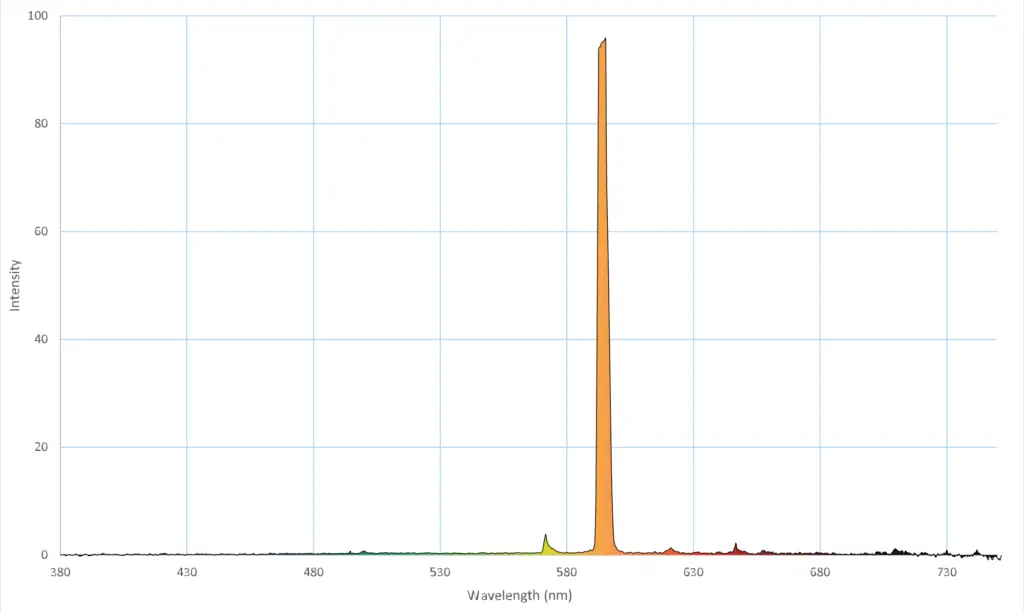
The best way this concept can be described is as a balanced relationship between the quality of light and the amount of light being emitted. The better quality of light you wish for the less light will be emitted.
This bulb in particular has however been made to maximize the amount of light it outputs without taking the quality of light into much consideration.
Usage
The main area of usage for the low-pressure sodium lamp is in road traffic. They primarily get used for highway lighting but also lighting for just about any other road that requires it.

They are great for this purpose because the quality of light doesn’t matter much in an area like a road and they produce a large quantity of light.
In fact, when it comes to roads the yellow light that gets emitted from these lamps can be rather beneficial. This is because we humans have easier time spotting contrasts and sudden changes in a yellow light, which is rather useful in a roadlike setting.
As time goes on though these are starting to become less common than they used to be. A lot of street lighting still uses these but it is slowly starting to be replaced by the more modern LEDs.
High-pressure Sodium Lamp
Specifications:
-Lifespan: 24 000 hours
-Efficiency: 40-140 lm/W
-Colour Temperature: 1900-2800K
-CRI: 25
How It Works
The high-pressure sodium lamp works using the very same principle for producing light as the low-pressure sodium lamp. The only difference between them is within the name, this one has a higher gas pressure within the tube.
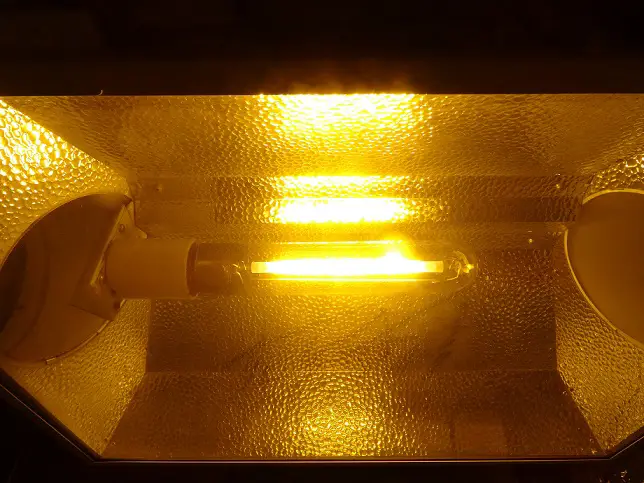
This increase of pressure causes a few changes in its behaviour and properties which will be discussed below.
Lifespan
One of the effects of increasing the gas pressure is an increased lifespan of the bulb, increasing it to around 24 000 hours. This happens because lamp operates more efficiently in terms of functionality and quality when increasing the pressure.
Efficiency
The luminous efficiency of the high-pressure sodium lamp is around 40-140 lm/W, which is a bit of a downgrade from the low-pressure sodium lamp which has a luminous efficiency of around 40-180 lm/W.
This is mainly due to the fact that high-pressure lamps lose more energy in the electrodes than low-pressure ones. Despite losing out on some luminous efficiency this bulb is still very efficient as it is.
Usage
Much like the low-pressure sodium lamps, the high pressure ones are also widely used within roads and traffic for a lot of the same reasons.
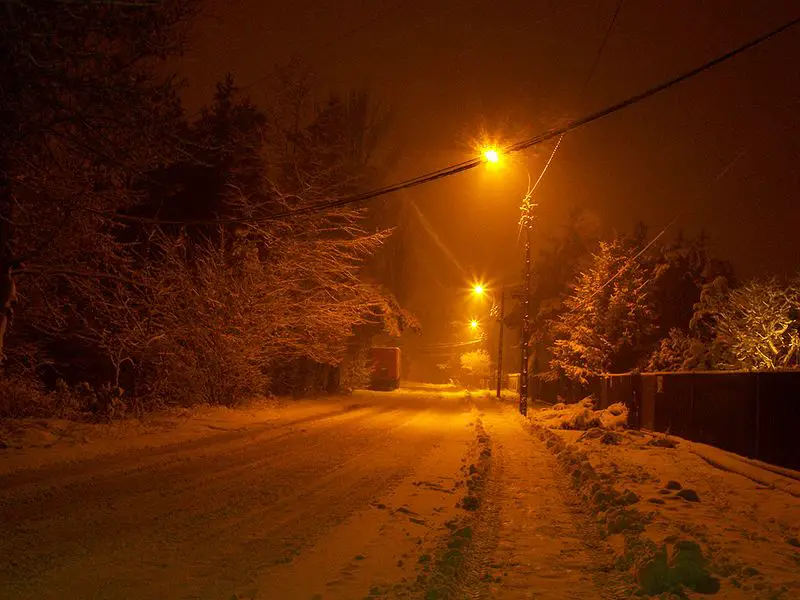
The high-pressure one is slightly more popular than the low-pressure one for this area though and that is because its quality of light is better.
Using a higher pressure in the lamp gives it a better quality of light, which in this case refers to it being a lot less yellow than the low-pressure lamp.
In comparison to any other bulb though they are still quite clearly yellow, they are simply less yellow than what they would have been otherwise.
Light Emitting Diode (LED)
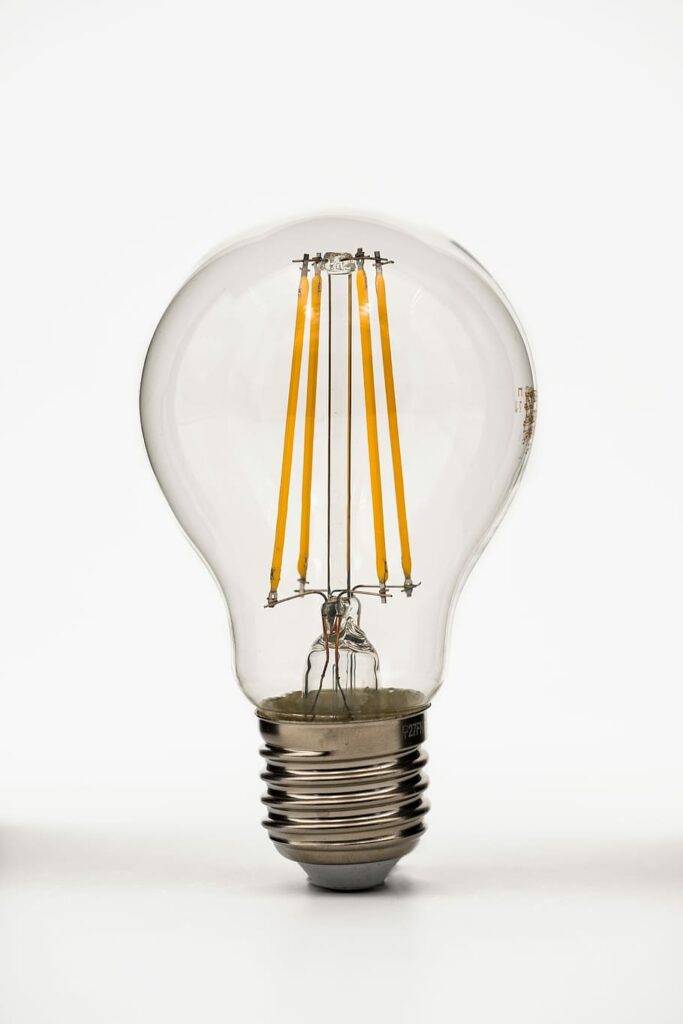
The Light Emitting Diode, more commonly known as LED, is one of the newest and most modern sources of light. They are completely made out of tiny diodes that all work together to create a uniform source of light.
Specifications:
-Lifespan: 50 000-100 000 hours
-Efficiency: 80-200 lm/W
-Colour Temperature: 2200-22 000K
-CRI: 80-99
How It Works
The LEDs functionality is actually rather simple. It consists of a lot of very small individual diodes of the colours red, green and blue which all come together to form a uniform white light.
This principle works due to the fact that when you mix light of the colours red, green and blue with each other the result is white light.
This is because white light is light that consists of all colours and we can create white light by simply bringing light of every wavelength together.

Lifespan
The lifetime of an LED spans around 50 000-100 000 hours, which is quite a bit longer than any other common bulb. At 50 000h it is able to stay lit up for about 5 and a half years without ever stopping.
The reason why the LED’s lifespan is so long depends on a few factors. One is the fact that we simply have a hard time actually measuring how long they are able to stay alive.
In order to measure a light source for 100 000 hours you would need to leave it on for 11 years without interruption. This is a very long testing time, so long that most products will never even be tested for this long at all.
What can be done instead is to simply track the rate in which it loses light output and then determine based on that data how long it will take for the bulb to stop producing light.
At this point it gets even trickier though, because an LED actually never stops producing light at a full stop like other bulbs do. This is because an LED doesn’t have any components that physically break like the other bulbs do.
An LED instead loses light steadily throughout its lifetime. This happens due to either individual diodes going out or because all the diodes naturally “decay“ in terms of light output.
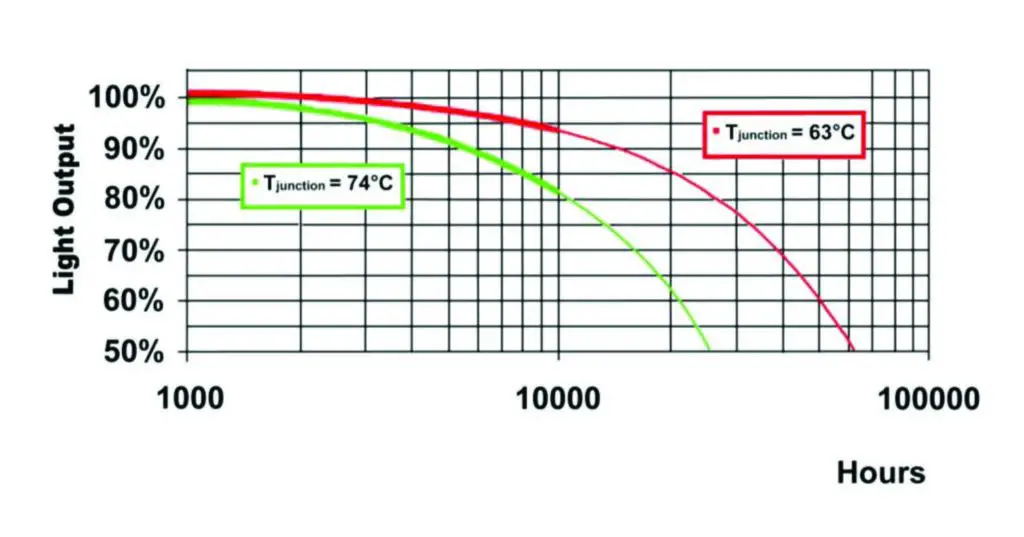
The lifetime can also depend on a few other factors such as heat, which the chart above illustrates. If you are interested further in more detail about the lifespan of an LED we suggest you go here.
Efficiency
The luminous efficiency of an LED can be anywhere between 80 to 200 lm/W. This makes the LED by far the most energy-efficient source of lightly constructed by humans so far.
There are a few reasons why it is so much more efficient than other light sources, one of them being that it produces a very small amount of heat compared to all other bulbs.
An LED only wastes about 5% of its inputted energy as heat, which is a very drastic improvement from the original incandescent bulb which wastes up to 95% of the energy input as heat.
This is because an LED consists of a lot of individual diodes that don’t require a lot of energy to emit light by themselves.
This means that there is very little opportunity for heat to build up in the first place, contrary to most other bulb designs.
There is one more factor that can make the LEDs efficiency fluctuate and this is the bulbs colour temperature. This is because the construction of the LED changes slightly depending on what colour temperature it is supposed to have.
A regular LED without modifications will have a default colour temperature of around 4000K. In order to reach the colder temperatures (4000K+) you simply modify the mixture of the individual diodes.
The way this is done is to simply alter the amount of blue diodes in relation to the red and green ones. In a regular LED you would keep the mix of these three equal, but if we instead want to make it emit a colder light we can simply increase the ratio of blue diodes to achieve this effect.
This doesn’t alter the energy usage much because the individual diodes use virtually the same amount of energy. There will be a very tiny difference but the difference here is so small that it doesn’t make much of an impact on the final energy usage.
If we instead want it to be a warmer colour however (4000K-) we need to do it in another way. If we were to apply the same principle of simply increasing the amount of red diodes we wouldn’t get the desired result.
What is done instead in order to make the LED warmer is to add phosphor to it. If we take a regular 4000K LED and physically apply phosphor the diodes it will cause them to emit a warmer light.
This happens because phosphor itself is rather yellow and when the light has to travel through a layer of phosphor it will become more yellow by nature and therefore will become a warmer colour.
Because the light has to travel through the phosphor it also loses a bit of its light output (lumen) in the process. This causes it to be less efficient in terms of lm/W because we are using the same amount of energy as a 4000K LED but output less light.
This can cause it to lose up to 10-15% of its total light output when compared to an LED without the addition of phosphor.
Usage
In terms of lighting technology, LED is currently number 1 in terms of specifications and technology used, so it also makes sense for it to be the most commonly used one today.
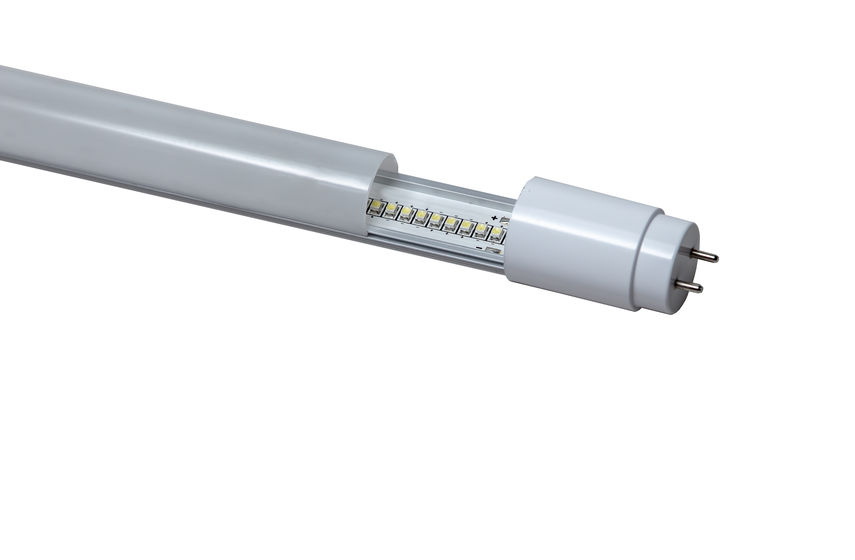
The very most common use for LEDs is generally speaking in large areas that simply need a large amount of light.
They work exceptionally well for areas like warehouses because they are extremely energy efficient on a scale that large and they require very little upkeep due to their long lifetime.
Generally speaking though they are used for just about any application imaginable due to them being a very versatile source of light.
They even manage to find their way into home environments because we have found ways to modify the colour temperature of the light to be a lot warmer.
The main reason it isn’t used absolutely everywhere without exceptions depends mostly on 2 factors. One factor is that the purchasing cost of an LED is generally a bit more than other bulbs.
The other factor is that another already existing bulb is most likely doing a better job at that specific task than an LED could. There are applications that LEDs excel at whereas there are other applications in which other bulbs do even better than an LED would.

